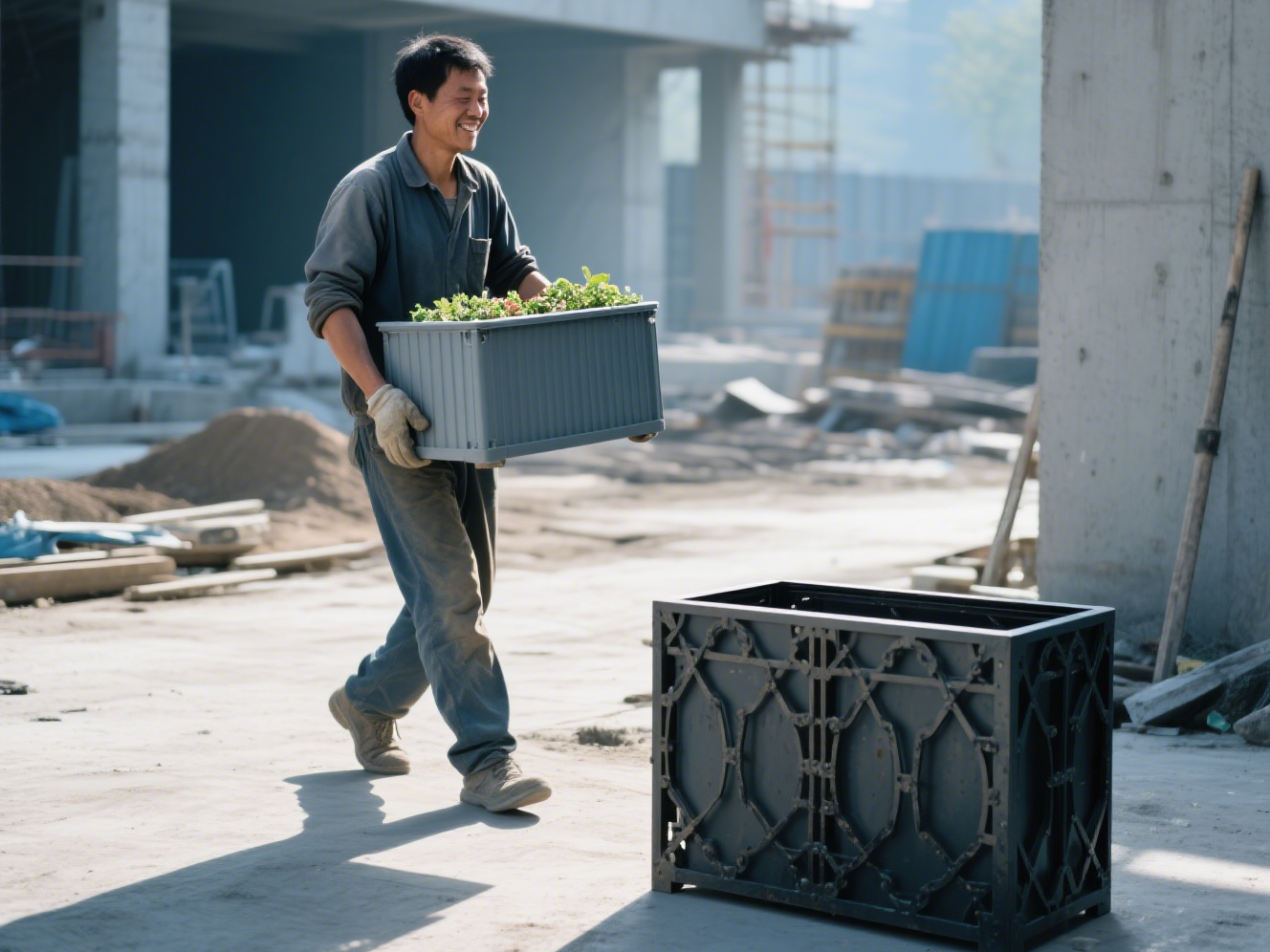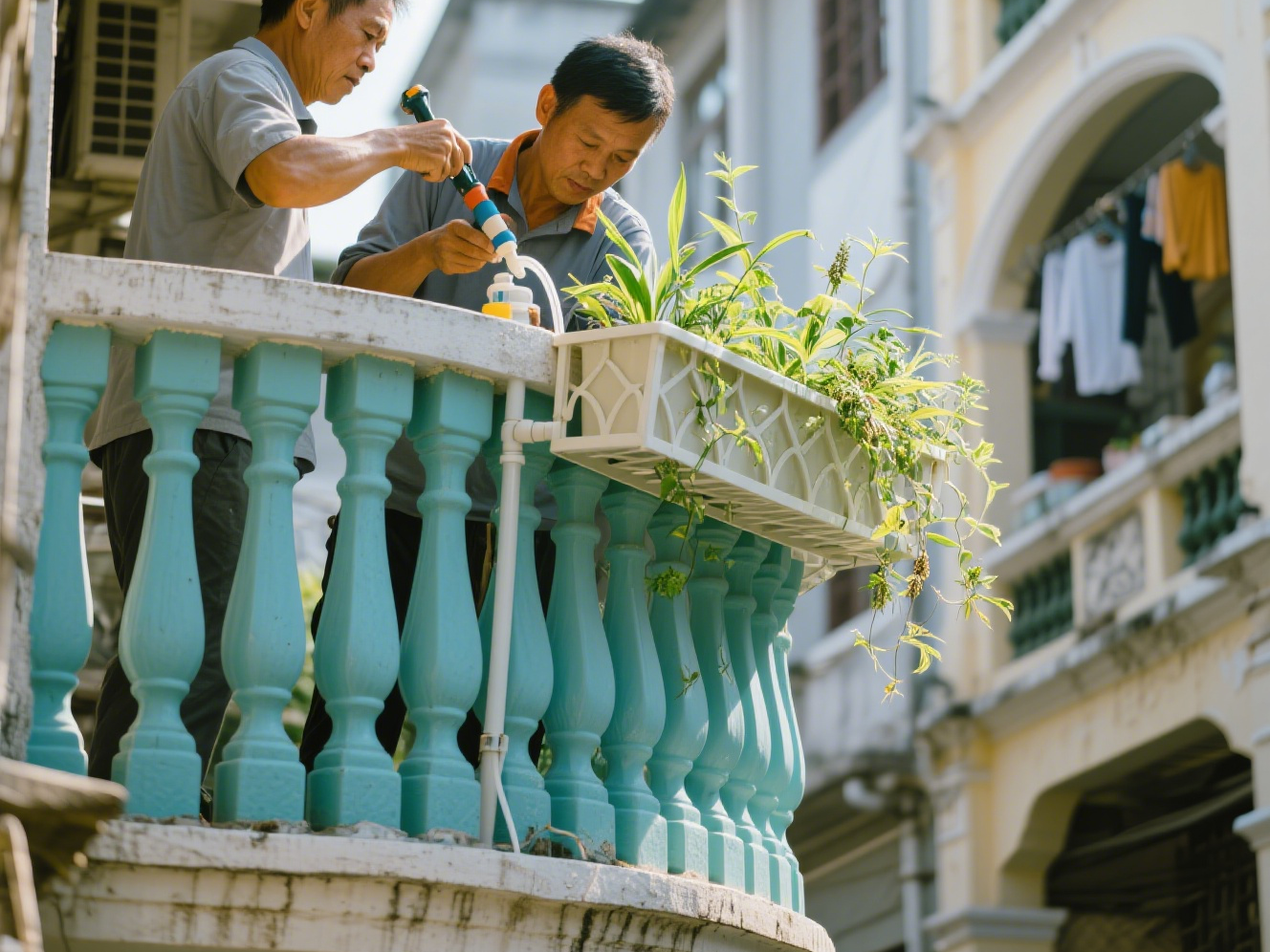At 6 a.m. in the arcade house on Enning Road, Liwan District, Aunt Zhang always first looks toward the wave-shaped PVC fence when lifting her balcony curtain. In the 4㎡ space, dewdrops hang from lettuce leaves on the three-tier PVC flower rack, chili vines climb through hooks on the fence’s waves, and cherry tomatoes glow red in the morning light—this PVC combination system from Qingyuan Fortune has not only freed her from termite-ridden wooden racks and rusty iron fences but also created a breathing “aerial vegetable garden” in the concrete old town.
A Vegetable-Growing Dream Eaten by Termites: A Decade of Troubles and Material Dilemmas
“Look at this wooden rack—painted just last year, now termites have gnawed holes in it,” Aunt Zhang points to the abandoned wooden flower rack in the corner, its crossbars densely covered) with termite trails that crumble at a light touch. In her decade living in old Xiguan, she’s replaced flower racks three times: the initial bamboo rack molded and broke in the plum rain season, the later iron rack stained the floor with rust, and the anti-corrosion wooden rack the year before last became a termite hotbed. “Once when my son brought his girlfriend home, she stepped on rust flakes from the balcony floor— I was so embarrassed I couldn’t speak for ages.”
Worse were the mosquito problems. Gaps in the iron fence became mosquito hideouts, and soil leaking through the rails during watering caused neighbor disputes. “During last year’s typhoon, rain washed potting soil all over the balcony—I squatted scrubbing for three hours,” she sighs, pointing to soil residue stuck in the floor drain. “My son keeps saying to stop growing vegetables—it’s unsanitary and troublesome—but I just want to pick pesticide-free greens for my grandson.”
The turning point came in a community group chat. When a neighbor sent a installation video of Qingyuan Fortune’s PVC wave fence, Aunt Zhang stared at the screen where workers glued components together: “No drilling? Waterproof? Termite-proof?” Half-doubting, she called the manufacturer, and the salesperson immediately recommended a custom “wave fence + three-tier rack” solution after hearing her troubles.

The Gardening Philosophy in 1.2 Meters: Three Wisdoms of Wave Design
On installation day, Aunt Zhang stayed on the balcony throughout. The construction team first dug a 20cm-deep trench along the balcony edge, buried the 1.2m-tall PVC wave fence posts, and fixed them with waterproof mortar. “The master said the wave-shaped top has a trick,” she points to the fence’s arc, “It makes rain flow outward along the curve, not splashing on seedlings; plus, bugs have to detour on the waves, much harder than climbing straight rails.”
The supporting three-tier PVC flower rack fixes to the fence’s inner side with L-shaped corner brackets. Each rack board tilts at 3°, edged with a 2cm-high water barrier forming a closed loop, and the bottom has evenly distributed 1cm-diameter drain holes. “What reassured me most was the material test,” Aunt Zhang shows chat records on her phone, “The manufacturer sent samples I soaked in water for three months and purposefully watered with rice-washing water for half a year—no termites, not even mold.”
Qingyuan Fortune’s technicians revealed the wave fence’s design inspiration comes from Lingnan arcade house drip eaves. “We studied Guangzhou’s climate—85% average humidity in plum rain season, 8-level winds in typhoon season,” an engineer explained during installation, “The PVC raw material contains imported antibacterial agents, making it termite-resistant and mold-proof. The wave structure reduces wind resistance by 20%—during last year’s test in Zhanjiang, the fence swayed less than 3mm in a level-10 typhoon.”

From Pest Prevention to Social Hub: 12 Kinds of Life in 4 Square Meters
Today the balcony is Aunt Zhang’s “pride and joy”. Ten pots of mosquito-repellent plants hang between the fence waves, their leaves releasing fragrance when gently shaken; on the three tiers, shade-tolerant lettuce and celtuce grow on the bottom, fruiting chili and cherry tomatoes on the middle, and bitter gourd vines climb the top. The smooth PVC surface rinses clean with a high-pressure water gun—no more worrying about soil clogging the drain. Last month during Typhoon “Sula”, she placed a water tray under the rack, collecting enough rainwater for a week’s watering.
“Now my grandson’s first thing after school is picking tomatoes,” Aunt Zhang points to a small ladder in the fence corner, “I deliberately left space on the bottom rack for him to reach. Last week, when neighbor Aunt Li saw my lettuce, she insisted on swapping two bunches of water spinach—now we chat daily on the balcony while exchanging vegetable seeds.” This unexpected social function delights her; the wave design of the PVC fence serves as a natural shelf, where neighbors place vegetable baskets, forming an unspoken “vegetable exchange station”.
What pleases her more is her son’s change of attitude. “Last time he brought colleagues home, he specially introduced the PVC vegetable garden, calling it ‘a blend of Guangzhou wisdom and modern materials’.” Aunt Zhang smiles, saying her son now volunteers to install an automatic watering device on the rack top and posts vegetable-planting videos in the family group. During a follow-up visit, Qingyuan Fortune’s after-sales team found she’d added hooks to the fence side for drying tangerine peel and roselle: “PVC isn’t afraid of sun—better than bamboo poles.”
Green Inspiration in Laoxiguan: When Industrial Materials Meet Urban Life
As the sun sets, Aunt Zhang’s PVC vegetable garden is gilded in gold. The fence’s wave arcs echo the arcade house’s Manchu windows, and trailing pothos vines cast dappled light through the fence’s voids. In this 4㎡ space, 12 kinds of vegetables not only meet daily needs but also connect neighbors emotionally. Last week, her garden won first prize in the community “Most Beautiful Balcony” contest, with judges noting: “It solves old-town planting problems with modern materials while preserving Xiguan life’s hustle and bustle.”

In this increasingly concrete-dense city, Aunt Zhang’s PVC garden is a warm footnote. When industrial materials blend into arcade balconies with wave-shaped soft curves, they not only solve humid planting challenges but also rebuild urban interpersonal connections with tangible greenery—not isolating nature, but using technological materials to create shared oases in cramped spaces, allowing the hustle and bustle of Laoxiguan to still nurture life poetry with earthy aroma. As Aunt Zhang often tells neighbors: “Vegetable growing values being grounded, but this ‘groundedness’ can also be connected with PVC pipes!”
